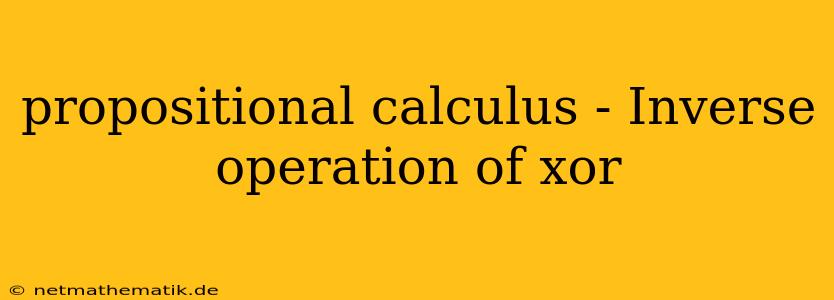Propositional calculus, a fundamental branch of logic, deals with propositions and their relationships. A proposition is a statement that can be either true or false, but not both. One crucial operation in propositional calculus is the exclusive OR, commonly denoted by XOR or the symbol ⊕. XOR is a logical operator that returns true if and only if one of its operands is true, but not both. While the operation itself is straightforward, understanding its inverse operation can be essential for various applications.
The Inverse Operation of XOR: Decoding the Truth
The inverse operation of XOR, also known as the exclusive NOR, is the logical operation that returns true if and only if both operands are true or both operands are false. This is in contrast to XOR, which returns true only when the operands have different truth values. Understanding this inverse relationship is key to understanding how to manipulate XOR expressions and solve logical problems involving XOR operations.
Representing the Inverse of XOR
The inverse of XOR can be represented in several ways:
- Logical NOT of XOR: This approach uses the NOT operator (¬) to invert the result of XOR. So, the inverse of (A XOR B) is ¬(A ⊕ B).
- Equivalence (XNOR): The inverse of XOR is often denoted as XNOR, using the symbol ≡. XNOR returns true when both operands have the same truth value.
- Using AND and OR: The inverse of XOR can be represented using a combination of AND (∧) and OR (∨) operators. The expression (A ∧ B) ∨ (¬A ∧ ¬B) effectively represents the inverse of XOR.
Truth Table Representation
A truth table is a useful tool for visualizing the relationship between logical operations and their inputs and outputs. Below is a truth table illustrating XOR and its inverse:
| A | B | A ⊕ B (XOR) | A ≡ B (XNOR) |
|---|---|---|---|
| T | T | F | T |
| T | F | T | F |
| F | T | T | F |
| F | F | F | T |
As the table shows, XNOR returns true when both A and B are true (T) or both are false (F), while XOR returns true when A and B have different truth values.
Applications of the Inverse of XOR
The inverse operation of XOR finds numerous applications in various fields:
- Cryptography: XOR is a fundamental building block in many cryptographic algorithms. Its inverse operation is crucial for decryption processes, where the original message needs to be recovered from an encrypted form.
- Error detection and correction: In communication systems, XOR is used to detect errors in data transmission. The inverse of XOR can help identify and correct these errors.
- Digital circuits: In digital electronics, XOR and its inverse play significant roles in designing logic circuits. They are used in implementing logic gates, flip-flops, and other essential components.
- Computer science: The inverse of XOR is widely used in programming languages for manipulating binary data, such as in bitwise operations.
- Artificial intelligence: XOR and its inverse are employed in machine learning algorithms, particularly in areas like neural networks and decision trees.
Practical Examples
Let's explore a couple of practical examples to understand how the inverse of XOR works in action:
- Data Encryption: Imagine you have a message "HELLO" that you want to encrypt using XOR. You can use a secret key "WORLD" to encrypt the message. Each letter is represented by its ASCII value, which is a numerical representation. Applying XOR to the ASCII values of each letter in "HELLO" with the corresponding letters in "WORLD" results in a ciphertext. To decrypt the message, you simply apply the inverse of XOR using the same key "WORLD."
- Error Detection: Consider a scenario where you are transmitting a sequence of bits over a noisy channel. Each bit can be represented by 1 or 0. Using XOR, you can calculate a parity bit for the transmitted data. If the receiver detects an error (a single bit flip), they can use the inverse of XOR to determine the location of the error and correct it.
Conclusion
Understanding the inverse operation of XOR is essential for effectively working with this crucial logical operator. While XOR focuses on differences in truth values, its inverse, XNOR, emphasizes sameness. This inverse relationship finds numerous applications in cryptography, error detection, digital circuits, computer science, and artificial intelligence. By grasping the nuances of XOR and its inverse, you can unlock a deeper understanding of logic and its applications in real-world scenarios.
